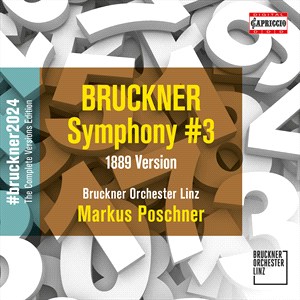

Bruckner aficionados have to deal with the often bewildering multiple revisions he and others did to many of his symphonies. His Symphony No. 3 is no exception. Indeed, it is one of the most revised of his cycle, with versions dating from 1873 (first full version), 1874 (revision of 1873 version), 1876 (second full version), 1877 (revision of 1876 version), 1889 (third full version), and 1890 (revision of 1889 version). There are additional smaller revisions, and transcriptions for organ and for piano (4 hands) but less commonly performed.
Opinions are divided on the best version, the most frequently performed now is the 1889 version. The edition can make a big difference. At the extreme the 1873 edition can take as long as 77 minutes (Tintner, a highly rated version). Poschner here (1889 version) lasts for only 47 minutes. Granted, Poschner uses fast speeds, exaggerating the timing difference, but it's almost a 50% difference in what is on the face of it the same work. Poschner and the Linz Bruckner Orchestra are progressing through each of the symphonies, recording all the major versions for each. The cycle is expected to be complete later in 2024.
Some commentators regard this 3rd symphony as the first major achievement in the overall cycle, and certainly many of the Brucknerian characteristics are present already. Lots of tremolo strings, massive blocks of sound alternating with sections of quiet reflection, the sections broken by pauses and with movements often containing extensive brass-led perorations. Thematic elements are typically simple, with dynamics that are usually very quiet or loud. The scope of each symphony tends to the monumental.
Poschner adopts brisk tempos overall, faster than many competing versions. Some commentators have felt uncomfortable with the tempos although I find them appropriate and find they minimize what might otherwise be heard as a stubborn stasis in the progress and development in the first two movements. If this symphony is a favorite of the potential buyer, they should be aware of the faster speeds to avoid an unwelcome surprise.
The recording acoustic is on the large side, which is typical for Bruckner symphony recordings. This creates a characteristic Brucknerian cathedral ambience. Given the stern architectural blocks of sound it is fitting but, in this case, does not significantly impede the overall instrumental clarity. I have found this factor more intrusive in some other versions such as the Paternostro/Württemberg Philharmonie Reutlingen version on Membran. I would personally prefer a drier acoustic. I find the echoes reverberating into sudden silent pauses after unison loud brass sections distracting. For example, the quiet ostinato on the strings that opens the first movement (such a typical Bruckner opening) generates tense expectation until the first orchestral climax breaks in allowing the echo to extend during the following pause. Outside of the ambience, the recording feels well-balanced, and I had no other issues with it.
The faster speeds help make the scherzo generate excitement, minimizing the potential ungainly march rhythm and give the peasant-like Ländler trio a little swing. The drums are clearly heard, giving an edge to the climaxes, and the movement passes quickly and enjoyably.
The finale, often the most difficult movement for Bruckner (and others) is handled with grace. Eugen Jochum used to talk about where the 'point of culmination' is in each of the symphonies. In the sixth symphony for example he would say it's in the 1st movement. In this symphony it feels very much to be in the first two movements. The scherzo and finale are generally the shortest and make simple listening in comparison. Poschner's tempos aid that process and lead the symphony to a triumphant and thrilling conclusion.
As a matter of interest, I also listened to the four hands piano arrangement of this symphony, arranged by Gustav Mahler, and played by Evelinde Trenkner and Sontraud Spiedel (on MD&G). It really presents a clarity to the overall symphony, especially useful in the first two movements, and looks at the work minus the overwhelming orchestra forces (and accompanying ambience), with all the major thematic elements emerging devoid of distractions. I would not suggest this as the alternative to the release under review, but it can be helpful in revealing aspects prior to the full orchestral experience.
Outside of this, alternative recommendations include Tintner and Francois-Xavier Roth for the 1873 version. It is worth listening to this early version in such thoughtful interpretations. But for the 1889 version some of the usual suspects like Gunther Wand (15+ releases!), Eugen Jochum, Stanislaw Skrowaczewski provide reliable recommendations. However, I liked this recording, and applaud the endeavor to record all the major revisions of each symphony with a common orchestra sound and conductor's vision. While I do not personally count the Symphony No. 3 as a favorite of mine in the Bruckner canon, I love the later symphonies, I found this a rewarding listen and recommend it to those not put off by the faster speeds.
Ian Orbell - March 2024 Scherzo